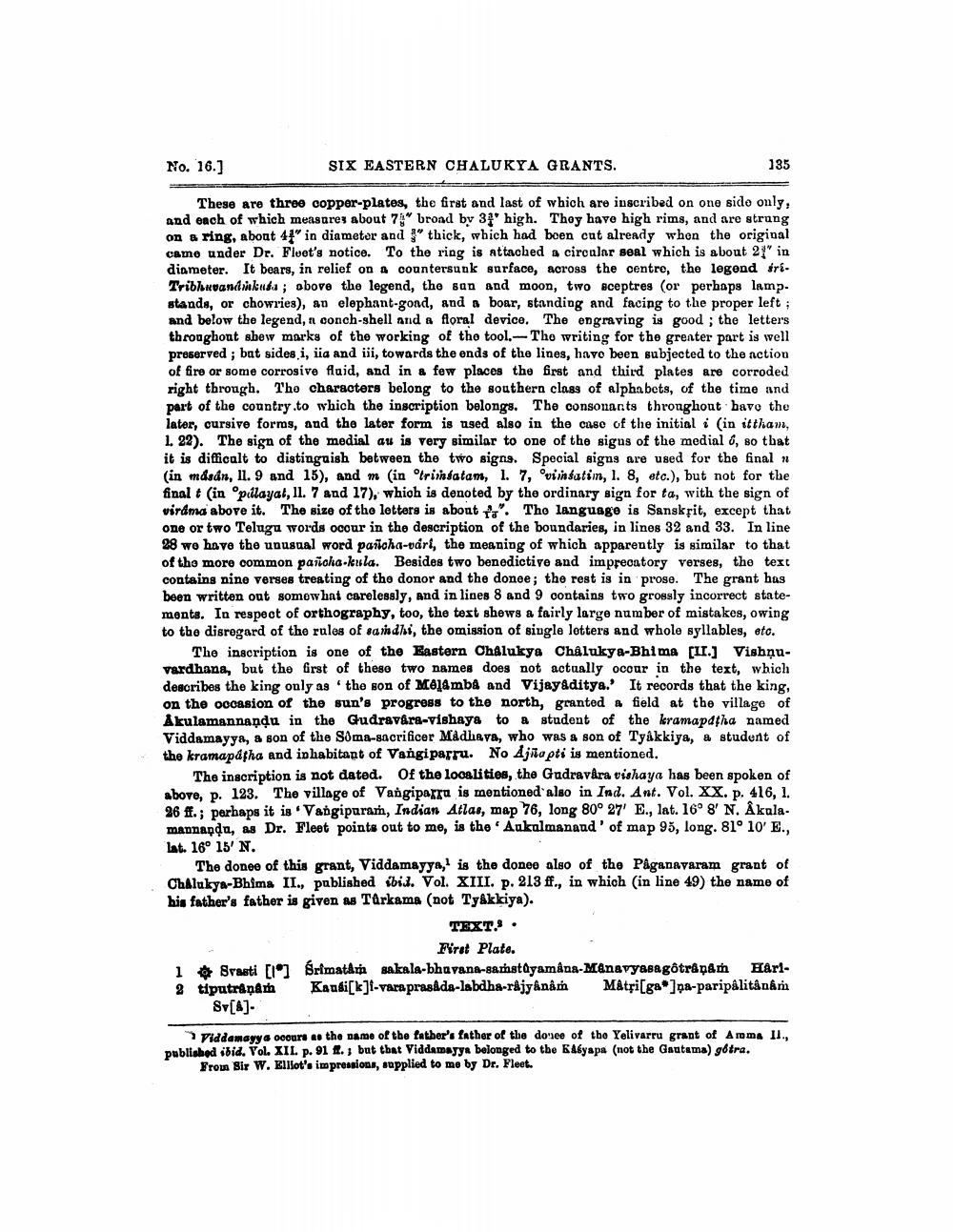________________
No. 16.)
SIX EASTERN CHALUKYA GRANTS.
135
These are three copper-plates, the first and last of which are inscribed on one side only, and each of which measares about 78broad by 31' high. They have high rims, and are strong on & ring, about 41" in diameter and I thick, which had boen cut already when the original came under Dr. Flvet's notice. To the ring is attached a circular seal which is about 21" in diameter. It bears, in relief on a countersunk surface, across the centre, the legend fráTribhuvandikuda; above the legend, the sun and moon, two sceptres (or perhaps lampstands, or chowries), an elephant-gond, and a boar, standing and facing to the proper left ; and below the legend, a conch-shell and a floral device. The engraving is good ; the letters throughout sbew marks of the working of the tool. - The writing for the greater part is well preserved ; bat sides i, iia and iii, towards the ends of the lines, have been subjected to the action of fire or some corrosive fluid, and in a few places the first and third plates are corroded right through. The characters belong to the southern class of alphabets, of the time and part of the country.to which the inscription belongs. The consonants throughout bavo the later, cursive forms, and the later form is used also in the case of the initial i (in ittham, 1. 22). The sign of the medial au is very similar to one of the sigus of the medial 6, so that it is difficalt to distinguish between the two signs. Special signs are used for the final » (in mdsán, 11. 9 and 15), and m (in trintatam, . 7, viisatin, 1. 8, etc.), but not for the final t (in piilayat, 11. 7 and 17), which is denoted by the ordinary sign for ta, with the sign of virama above it. The size of the letters is about 1". The language is Sanskpit, except that one or two Telugu words ocour in the description of the boundaries, in lines 32 and 33. In line 28 we have the unusual word paricha-várt, the meaning of which apparently is similar to that of the more common paiicha-kula. Besides two benedictive and imprecatory verses, the text contains nine verses treating of the donor and the donee; the rest is in prose. The grant has been written out somewhat carelessly, and in lines 8 and 9 contains two grossly incorrect statemonte. In respect of orthography, too, the text shews a fairly large number of mistakes, owing to the disregard of the rules of sandhi, the omission of single letters and whole syllables, etc.
The inscription is one of the Eastern Chalukya Chalukya-Bhima [I.] Vishnuvardhana, but the Grst of these two names does not actually ocour in the text, which describes the king only as the son of Molamba and Vijayaditya.' It records that the king, on the occasion of the sun's progress to the north, granted a field at the village of Akulamannaudu in the Gudrsvars-vishaya to a student of the kramapatha named Viddamayya, a son of the Soma-sacrificer Madhava, who was a son of Tyakkiya, a student of the kramapdfha and inhabitant of Vangiparru. No Ajnopti is mentioned.
The inscription is not dated. Of the localities, the Gudravåra vishaya has been spoken of above, p. 123. The village of Vangiparra is mentioned also in Ind. Ant. Vol. XX. p. 416, 1. 26 ff.; perhaps it is. Vangipuram, Indian Atlas, map 76, long 80° 27' E., lat. 16° 8' N. Åkulamannanda, as Dr. Fleet points out to me, is the 'Aukalmanaud' of map 95, long. 81° 10' E., lat. 16° 15' N.
The donee of this grant, Viddamayya, is the donee also of the Påganavaram grant of Chalukya-Bhima II., pablished bil. Vol. XIII. p. 213 ff., in which in line 49) the name of his father's father is given as Tärkama (not Tyakkiya).
TEXT..
First Plate. 1 Srasti [1] Srimatan sakala-bhavana-samstayamâna-M&navyasagôtränar Hari2 tiputrinam Kausi[k]i-vara prasada-labdha-rajyanam Matri[ga]ņa-paripálitânâm
Sv[4]
Viddamayya ooours as the name of the father's father of the dose of the Yelivarru grant of Aroma II., published ibid. Vol. XII. p. 91 1., but that Viddamayya belonged to the Abyapa (not the Gautama) gotra.
From Sir W. Ellot's impressions, supplied to me by Dr. Fleet.




